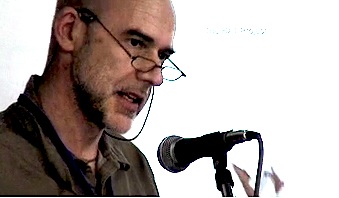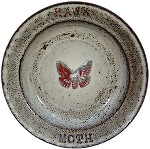Steve Dixon
‘Beyond the Seas: the effects of dislocation on material culture and craft practice’.
‘Beyond the Seas’, a practice-led research project, will investigate the ways in which cultural and geographical dislocation influences craft practice and material culture. This will be achieved through an examination of the effects of dislocation on my own craft practice, informed by study of the effects of displacement on the early Australian colonists (as evidenced by historical artefacts) study of the effects of colonisation upon the craft traditions and practices of indigenous Aboriginal cultures, and exploration of the creative and cultural tensions between traditional and contemporary craft practices in Australia. ‘Beyond the Seas’, will take the form of a twelve-week studio-based research residency at The Jam Factory, Lion Art Centre, Adelaide, Australia, followed by a twelve-week period of studio-based research in the UK.
Research question.
What are the effects of dislocation on cultural identity, craft practice and material culture? ‘Beyond the Seas’ will address this question within the specific context of the Australian colonial experience and its legacy. Australia provides a uniquely appropriate case study, having experienced extremes of cultural displacement and dislocation, both from the perspective of the colonists and settlers, and the indigenous Aboriginal population. Robert Hughes has eloquently described the psychological effects of such a profound geographical dislocation, within the context of convict transportation to Australia; ‘‘It made sense, of a kind, to assume that the further south one went, the more grotesque life must become. What demonic freaks, what affronts to normality, might the Southern Continent not produce? Within its inscrutable otherness, every fantasy could be contained; it was the geographical unconscious.’’ 1
Examination of associated questions, around issues of dislocation, will inform this study: · What evidence is provided by the historical artefacts and material culture of the colonists and settlers? · How do these colonial artefacts differ from artefacts produced in the UK? · Were the reasons for these differences technical? Practical? Social? Political? · Were the differences radical or subtle? Were new forms of artefact created? · How were Aboriginal craft traditions dislocated during the colonial period? · Has globalisation and the communication revolution more recently affected indigenous craft practices? · To what extent are traditional and contemporary craft practices compatible? · Is there a cultural/ethnic split between the two, and is this a reflection of more deep-seated cultural tensions? Primarily, the project will examine how this question can be addressed through informed and reflective contemporary craft practice. It will explore how these issues can be communicated to new audiences through new models of socially engaged practice.
Project aims.
‘Beyond the Seas’ aims to: · Achieve new insights into the effects of cultural dislocation on craft practice. · Develop and demonstrate new models of socially engaged craft practice. · Deliver these insights within a significant new body of work. · Disseminate these new knowledges through public exhibitions, conference presentations and the publication of Journal articles. · Contribute to the wider HAT Asia/UK international research project, and feature in the project publication and documentation. · Build upon the successful research partnership achieved between Manchester Metropolitan University and the 2003 HAT pilot project. (www.hat.mmu.ac.uk)
Research context.
The context of my own research. My research is focussed on the development of a contemporary political narrative for ceramics. Early work exploited the language of the satirical cartoon, referencing figurative traditions and popular commemorative wares in order to interrogate contemporary issues and events. At Manchester Metropolitan University, my research into political content has focussed on the printed image, and on the development of an ‘allegorical’ narrative, based on a layering of visual metaphors. These printed ceramic narratives both reflect upon and document the political, ethical and cultural challenges of our times. Events surrounding the recent war on Iraq are central to my most recent body of work. An engagement with the issues of cultural identity and dislocation implicit in ‘Beyond the Seas’ within the wider context of the HAT Asia/UK research imperatives, will allow me to continue to develop this model of politically engaged practice.
The context of wider issues and debates. This project will contribute to wider contemporary debates around issues of material culture; what is it that constitutes ‘culture’, how is this defined, who by, and who for? In recent years, ceramic artists in Britain have increasingly engaged with cultural, social, and political commentary within their practice. They have added issues of national, social and sexual identity, political protest and environmentalism to the ‘ceramic canon’ of visual culture. This phenomenon has been documented and theorised by critics Garth Clark, Moira Vincentelli and Amanda Fielding, who has written; ‘’Dixon Belongs to a cluster of ceramicists in the UK including Richard Slee, Carol McNicoll, Philip Eglin, Grayson Perry and Paul Scott. Their work is characterised by wit, observation and allusion to a broad range of contemporary issues. In their hands, usually innocuous domestic objects, such as teapots, plates, buckets and vases, are scaled up and transformed into complex carriers of alternative ideas.’’ 2
Research methods.
Issues of cultural dislocation will be examined from a number of perspectives, using a variety of primary research methodologies: visual/’forensic’/academic study, fieldwork, and practice-led investigation in the studio. Secondary research will be undertaken prior to the residency period, consulting a range of appropriate texts on post-colonialism, fieldwork, and material culture. 3
Access to historical and ethnographic collections and archives will be fundamental to the contextual development of the project. In particular, collections of the artefacts and material culture of the colonists and settlers, and the tools, weapons and craftworks of Aboriginal cultures will be examined. This examination will be visual (through drawing and a first-hand engagement with the objects) ‘forensic’ (through a metaphorical deconstruction of the use, purpose and significance of the objects) and academic (through a study of related text and documentary material.) Negotiated visits will be made to study appropriate collections of indigenous art, decorative art and design, and social history, at the South Australia Museum, the Powerhouse Museum, Museum Victoria, and the National Museum of Australia.
Practical study ‘In the Field’ will be facilitated by residency hosts The Jam Factory, through their association with Ernabella Arts, an Aboriginal artist group located in the Musgrove Ranges, northern South Australia. This will enable me to develop contacts and working relationships with practising indigenous artists (potentially through creative collaboration) and to record valuable insights into personal experiences of cultural dislocation. This phase of the project will involve individual interviews, with audio, photographic and video documentation where appropriate.
In the Jam Factory studio I will access a wide range of ceramic facilities, as well as photographic, computer and I.T. equipment. My practice-led studio research will be ‘responsive’, feeding upon the archive of research material assembled through museum study and fieldwork. It is not envisaged that research outcomes will be resolved during the period of the research residency, rather that new lines of investigation will be opened up, and new models of practice initiated. A further research period of three months, following my return to UK, will see this material worked up into a new body of ceramic practice, as a fully resolved research outcome.
Endnotes:
1. ‘’The Fatal Shore’’ (Hughes, R. 1987, p.44).
2. FIELDING, A. (2005) ‘’Stephen Dixon: Armchair Politico?’’ in Mitchell, L. (ed.) The Sleep of Reason. Manchester: Manchester Art Gallery.
3. BARRINGER, T. and FLYNN, T. (1998) Colonialism and the Object: Empire, Material Culture and the Museum. CLIFFORD, J. (1988) The Predicament of Culture: Twentieth Century Ethnography, Literature and Art. THOMAS, N. (1999) Possessions: Indigenous Art/Colonial Culture. WOLCOTT, H.F. (1995) The Art of Fieldwork.
CHAT WEEK

Click on image to open QuickTime movie
"ARTIST'S TALK"
Steve Dixon talks to conference during cHAT week at Sanskriti, Delhi, India. March 2007
------------------------------
ONE YEAR ON

Watch Steve Dixon's presentation "one year on" given at cHAT week in Sanskriti, New Delhi: Click on image to watch movie (Duration 36 Mins)
DOCUMENTATION

A small web site showing the enamelled plates Steve created during his time at the Jam Factory.
See Steve's plates

Steve Gets 'Hooded Up'
A visit to Steve's studio in Manchester to make a short film, click here to see some stills
Documentation ©2006 Johnny Magee





